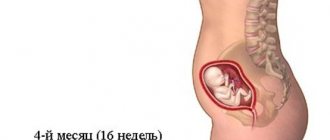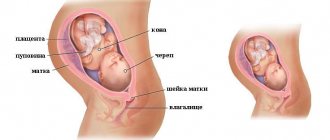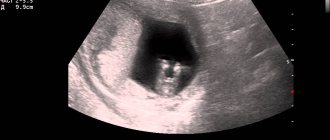At the beginning of the second half of the perinatal period, repeated planned screening is carried out. According to the pregnancy management program, the time for a complete examination in the second trimester is determined from 20 to 24 weeks. Blood tests for hormones and ultrasound at 21 weeks of pregnancy are mandatory monitoring procedures. Additionally, the following may be prescribed:
- Dopplerography (assessment of the condition of blood vessels);
- amniocentesis (surgery to remove fetal fluid for laboratory analysis);
- cordocentesis (puncture of umbilical cord vessels).
A special examination is carried out in case of failures and irregularities detected by ultrasound. Laboratory microscopy includes quantitative characteristics of the following indicators: alphafetoprotein (AFP protein), “pregnancy hormone” or human chorionic gonadotropin (hCG), free estriol (EC). Standard indicators must correspond to the figures given in the table.
Overestimated or underestimated indicators most often indicate genetic developmental abnormalities
The course of pregnancy and possible pathologies are assessed based on the results of ultrasound and laboratory tests.
Why and to whom is examination recommended?
21 weeks can be called the middle of the entire pregnancy period. At this time, the size of the abdomen is already significantly noticeable, and the baby himself has almost all formed internal and external organs, which smoothly move into the stage of improvement.
At this time, it is important to study the condition of the mother and her genital organs, and it is also necessary to check the possibility of delayed development of the fetus. For this purpose, there are certain canons with which the data obtained can be verified.
In some cases, additional studies and analyzes may be necessary, for which you need to be prepared. They are usually needed if abnormal development is suspected and there is a high risk of miscarriage. Also in this case, an additional visit to the ultrasound room may be scheduled.
Important! Skipping routine examinations is highly discouraged, as they are necessary to monitor fetal development and make prognoses.
What happens to your baby during a fetal ultrasound at 21 weeks of pregnancy?
Fetal growth on fetal ultrasound at 21 weeks of gestation averages 17.5 cm and weighs approximately 350 grams.
As mentioned above, the child began to feel taste. By swallowing several grams of amniotic fluid every hour, the child experiences a new taste. The taste of amniotic fluid changes depending on what you eat. The swallowing process is necessary in order for the fetus to prepare for existence outside its cozy home (your uterus). Swallowing water stimulates the child’s digestion, floods it, and slightly nourishes it. With an ultrasound of the fetus at 21 weeks of pregnancy, you can clearly see how the fetus is actively making swallowing movements.
If you want your child to eat carrots, eat them now!
The fetus still has a lot of space inside the uterus. This allows the baby to move quite freely, which can be seen not only with an ultrasound of the fetus at 21 weeks of pregnancy, but simply with the naked eye! The child is still able to calmly turn upside down and in the opposite direction. If your baby is very active and has a long enough umbilical cord, he may wrap it around his limbs, body, or neck. It is extremely rare for a true umbilical cord knot to occur when the umbilical cord is tied into a knot. These complications of pregnancy are visible during ultrasound of the fetus at 21 weeks of pregnancy, especially when using https://ultraclinic.com.ua/diagnostika/uzi/3d-4d-uzi/ during pregnancy.
The umbilical cord being wrapped around the fetus's neck is not a big problem. In most cases, with entangled births, the umbilical cord is removed after the baby's head is born. Then the child is born without any difficulties. Exceptions include tight umbilical cord entanglements. Such tight entanglement is diagnosed by ultrasound of the fetus at 21 weeks of pregnancy or at other times at https://ultraclinic.com.ua/diagnostika/uzi/dupleksnoe-skanirovanie/. In cases of tight entanglement, the child cannot be born on its own; a cesarean section is resorted to.
Despite the constant dancing in the stomach, your baby sleeps 12-14 hours a day. Periods of sleep and wakefulness constantly alternate. When performing an ultrasound of the fetus at 21 weeks of pregnancy, at least one such period of change between these two states can be determined. Ultrasound is perceived by a child in the same way as by an adult. He reacts more to new, unfamiliar voices and to mechanical pressure with a sensor during an ultrasound scan of the fetus at 21 weeks of pregnancy, and at a later date.
Mother's condition and fetal development
Usually at this stage the expectant mother does not feel nausea and other unpleasant sensations that were dominant in the first weeks of pregnancy. However, it can perceive pressure on the spine that the fetus creates. However, it will intensify over time.
At 21 weeks of age, the unborn child begins to develop an addiction to the food that the mother consumes. His body begins to become more proportional, his legs lengthen. The head acquires a light coat of hair, resembling fluff, and thin eyebrows and eyelashes grow. If the angle is right, you can also see the baby’s finger on the monitor, which he uses as a pacifier.
The child's spleen and liver begin to work actively. The pituitary gland, thyroid and sex glands, pancreas, and adrenal glands also function.
The child's body and face are usually covered with small wrinkles and depressions. This is due to the fact that in the twenty-first week the adipose tissue is not sufficiently formed.
At this time, you need to pay attention to what a pregnant woman wants to eat, even if we are talking about harmful foods. It is not recommended to completely exclude them from the diet; it is enough to reduce their number.
Recommendations for the expectant mother
- Don't miss an opportunity to communicate with your child. He listens carefully to what is happening in the mother’s body and outside the womb. After birth, he will definitely recognize your voice among everyone else.
- Do not lift heavy objects and avoid situations that can cause stress and nervous tension.
- Visit your gynecologist regularly to keep your well-being and your child's development under control. Follow all recommendations.
- It's time to sign up for courses for expectant mothers. The knowledge gained in the classes will be useful in the last months of pregnancy, as well as during and after childbirth.
- Eat a healthy diet and watch your weight.
When swelling occurs, you must take a lying position with your legs raised up. To prevent them, you need to limit your salt intake and also change your body position more often.
What can be seen in the photo of the fetus?
In the photo taken using an ultrasound machine, you can see the body of an almost fully formed child. It is easy to see his limbs, ears and nose, fingers, umbilical cord and placenta.
The child’s genitals are practically developed, so in girls you can see the outer labia, in boys you can see small testicles and a penis.
Reference!
The most complete and accurate picture can be seen using the latest equipment, including those that create a three-dimensional image.
Photo of a boy
Photo of a girl
What are they watching?
In 9 months, the fetus develops in the womb from a fertilized oocyte to a whole person. At week 20, the baby’s teeth are already beginning to form, the baby’s skin is fully formed and hair is beginning to grow. The baby's organs are almost formed, the eyes open slightly and the baby sucks his thumb.
What to look for at the second ultrasound during pregnancy:
- Number of fruits and their sizes;
- Fetal presentation;
- If there is entanglement in the umbilical cord;
- Condition of the uterus;
- The amount of amniotic fluid;
- Condition of the placenta;
- Gender of the child is optional.
An ultrasound allows you to assess whether the baby is developing correctly and whether he has enough nutrition. If any abnormalities are observed, the mother may be advised to be hospitalized to maintain the pregnancy, or to be observed by a doctor in a clinic and take medication.
Decoding the results: normal indicators
Hardware inspection is also needed to compare the data obtained with the reference data, that is, with generally accepted standards.
Basic indicators of the norm:
- height - about 18 centimeters;
- weight – approximately 360-400 grams;
- abdominal circumference – from 140 to 175 millimeters;
- the distance from one temporal bone to the other is approximately 55 millimeters;
- head circumference – about 200 millimeters;
- the length of the thigh bone is 40 millimeters, the length of the tibia is 35 millimeters;
- the length of the humerus is from 30 to 37, the forearm is from 24 to 32 millimeters.
The doctor conducting the examination must record the presence of both kidneys, 4 chambers of the heart, the presence of a liver and spleen.
Risks
With the beginning of the 6th month, the load on a pregnant woman’s body rapidly increases, so some problems may worsen:
- heartburn - the fundus of the uterus rises above the level of the navel, the abdominal organs are compressed and displaced, due to pressure, part of the contents of the stomach can enter the esophagus, to cope with discomfort, you need to eat small meals, exclude spicy, fried and fatty foods from the diet, move after eating or walk;
- constipation - a compressed intestine pushes food through worse, and due to difficult peristalsis, difficulties with bowel movements may arise; consuming enough fiber-rich and fermented milk products will help to avoid them; in extreme cases, with the permission of a doctor, you can take a herbal laxative;
- hemorrhoids - an increase in the volume of blood circulating in the body, coupled with constipation and a sedentary lifestyle, often causes the formation of hemorrhoids; pain, itching and bleeding are eliminated with ointments and suppositories, which should be prescribed by a doctor;
- temperature - due to weakened immunity, expectant mothers more often suffer from colds, so you need to take care of prevention (rest more, adjust your diet, avoid crowded places), and at the first symptoms of the disease, consult a doctor for advice;
- late toxicosis - if a woman feels sick, as in the first trimester of pregnancy, she needs to be examined for gestosis;
- insomnia - disruption of biorhythms and active movements at night disrupt sleep patterns, you need to follow a rest and work schedule, move more, do not eat 2-3 hours before bedtime and often ventilate living and working areas.
Where do they make it and how much does it cost?
Like many other important examinations, an ultrasound scan can be performed at any suitable free hospital. Since this examination is routine, doctors do not have the right to refuse it regardless of the circumstances, even if the woman is not worried about anything.
Before visiting the clinic, you need to prepare for a long line and arrive early. You should not take food or drinks with you, so you will have to endure hunger and thirst for some time.
Things are different with paid clinics. An ultrasound in such an institution can cost from 1,500 to 5,000 rubles at any stage of pregnancy. At the same time, the highest prices can be expected in those institutions that have the most modern and high-quality equipment installed.
As a rule, they have shortened queues (or none at all); ultrasound examinations are often performed by appointment. No additional hygiene products are required for the procedures; disposable diapers are usually provided in clinics free of charge.
Reference! If you feel unwell or have a high risk of abnormal pregnancy development, it is best to choose paid clinics. In this way, the time spent in hospital can be reduced. However, if any additional tests are needed, they can be expensive here.
Indications and contraindications
An ultrasound scan at the 21st week of pregnancy is included in the standard examination of women; an ultrasound scan in the 2nd trimester is performed for everyone. There are no contraindications to it. The only reason why the examination may not be carried out is the woman’s reluctance.
In this case, an official document is drawn up - a refusal, which is glued to the pregnant woman’s exchange card.
To watch a video review from a doctor about pregnancy:
Who is indicated for a second screening?
If a pregnant woman has encountered factors that increase the risk of malformations and chromosomal abnormalities, she should definitely undergo a second screening. These factors are:
- woman's age over 35 years;
- presence of hereditary diseases in the family;
- congenital malformations and/or chromosomal abnormalities in previous pregnancies;
- the threat of miscarriage in the short term of this pregnancy;
- the presence of harmful environmental or occupational factors;
- bad habits;
- history of spontaneous miscarriages;
- a viral infection suffered in a short period of time;
- taking illegal drugs;
- conception in conditions of consanguineous relationships.
How is the ultrasound protocol deciphered?
The ultrasound results are interpreted according to a generally accepted plan, which is called a protocol. The following characteristics are recorded in the protocol:
- Placental state. Normally, the placenta has a zero degree of maturity, infarctions and calcifications are absent. During normal pregnancy, the placenta is attached to the wall of the uterus. A serious deviation is the location of the placenta close to the internal os (closer than 70 mm) or the overlap of the os with the placenta.
- Condition of the umbilical cord. During these weeks of pregnancy, the presence of entanglement is not indicated, since the baby is still actively moving and will repeatedly change its position. The number of vessels is determined. Normally there are three of them: two arterial vessels and one venous. With fewer blood vessels, the fetus may develop oxygen starvation. A Doppler ultrasound is performed and treatment is prescribed depending on the results.
- Amniotic fluid. If the amniotic fluid is less than normal, a diagnosis of oligohydramnios is made. This pathology develops as a result of an intrauterine infectious disease and may indicate fetal malnutrition. With polyhydramnios, a diagnosis of polyhydramnios is made; it occurs as a complication of an infectious disease, or indicates a malfunction of the fetal urinary system.
- Cervical length. This indicator should be more than 2.6 cm. Normally, there is complete closure of the internal and external pharynx.
- Vices. The identified defects are described or their absence is indicated.
- Floor. Determines the gender of the child.
During an ultrasound, the doctor must diagnose the condition of the umbilical cord and the number of vessels in it. At this stage, it is not yet possible to detect the entanglement of the umbilical cord, since the baby is actively moving and can change its position many times
Procedure
Ultrasound of the second trimester does not require special preparation and is no different from the previous study. A woman does not need to starve or follow any diet or drinking regime. You just need to come to the office 10 minutes before the appointed time, take a towel and a disposable diaper with you.
If the first study is carried out using two methods: through the vagina or the anterior wall of the abdomen. Then the ultrasound at 20 weeks is performed only transabdominally, that is, the doctor moves the sensor over the tummy.
First, the woman is asked to undress and lower her underwear. A diaper is placed on the couch and the patient lies on her back. The doctor applies a special water-based gel to the skin, which improves the conductivity of ultrasound, and applies a sensor.
The duration of the procedure depends on the type of ultrasound. The 2D procedure takes no more than 15 minutes, and the 3D procedure takes about 30 minutes. The time difference arises due to the need for the computer to process a larger amount of information, producing a three-dimensional image.
After the examination, the pregnant woman needs to slowly get up from the couch, wipe off the remaining gel with a towel and get dressed. The conclusion is usually given to the patient within 15 minutes after the procedure.











